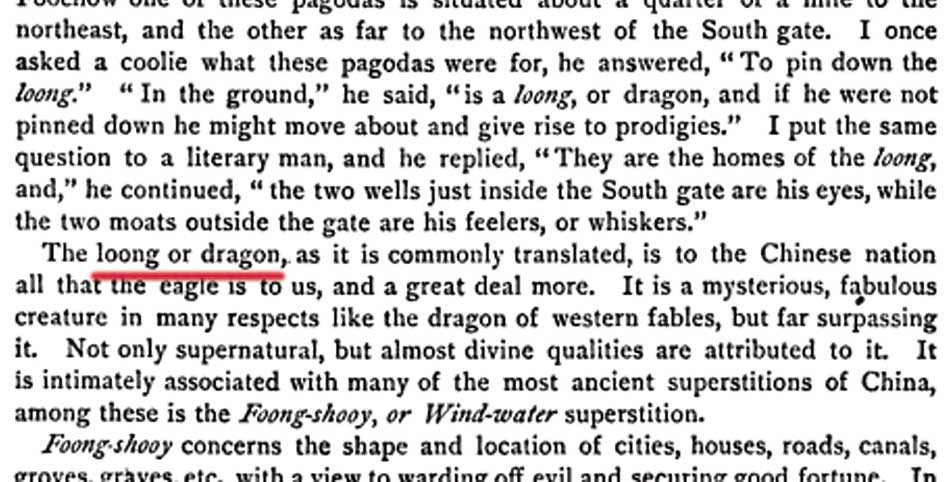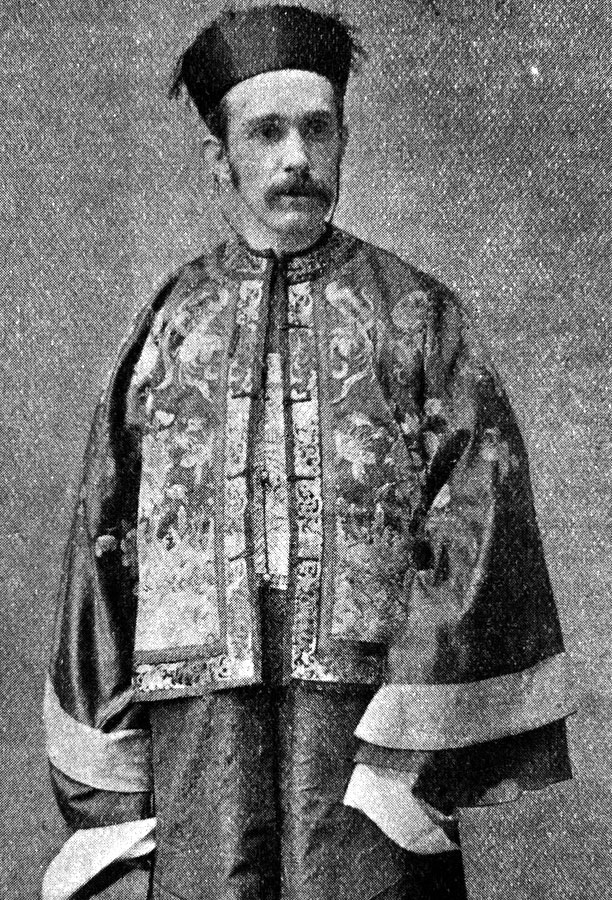

返回首页 《译龙风云——文化负载词的翻译:争议及研究》免费下载 |
|
Dragon TV 放映杀死 dragon 的画面 黄佶,2017年4月8日 |
上海东方卫视的英文名称是 Dragon TV(图1)。昨天,它报道俄罗斯联邦调查委员会抓捕恐怖嫌疑人时(图2,3),出现了该委员会的标志:一位武士正在杀死一头 dragon(图4)。两相对照,十分有趣。
|
|
|
|
Dragon(杜拉更)是欧洲神话中的虚构动物,主要象征邪恶。在俄罗斯的国徽上,也画着英雄杀死杜拉更的场景(图5)。
|
|
中国的龙和杜拉更截然相反,象征吉祥和喜庆。早在十九世纪,就不断有外国人指出中国的龙和欧洲的杜拉更是两回事。 1882年,在中国邵武(Shau-wu)工作的美国牧师 J.E. Walker 发表了一篇文章:“Pagoda, Loong and Foong-Shooy”(宝塔,龙和风水)。 他在文章中写道:“The loong or dragon, as it is commonly translated, is to the Chinese nation all that the eagle is to us, and a great deal more. It is a mysterious, fabulous creature in many respects like the dragon of western fables, but far surpassing it. Not only supernatural, but almost divine qualities are attributed to it. ...” 这段文字的中文含义是:“龙通常被译为 dragon,它对中华民族的意义就和鹰对我们的意义完全一样,甚至有过之而无不及。它是一种神秘的、巨大的生物,在很多方面和西方神话中的杜拉更相似,但远远优于杜拉更。它不仅是超自然的,而且还被赋予了近乎神圣的特质。……” 可见当时已经有外国人很清楚龙和杜拉更是存在差异的,而且已经用音译新词 loong 来特指龙。 |


图4-5-2,书籍封面、内页和局部放大:
The Missionary herald at home and abroad: Volume 78,1882年出版。
Google Books
------------------------------
|
1931年2月12日,牛津大学汉语教授 William Edward Soothill(中文名“苏慧廉”)牧师在英国皇家亚洲文化协会(Royal Asiatic Society)做了一场报告,他说: ……. Again, in China, it is always beneficent, while the dragon of the
west, for the most part, has been considered as maleficent, injuring the
people, stealing princesses, and calling forth the heroism of, say, a
St. George, for its destruction. So different are the two conceptions that it would almost seem wiser
to call them by different names, adopting the Chinese name Lung for their
national benefactor. That the Lung is so considered is evident from the
rejoicing evinced at the Dragon festival at the first full moon of the
year, when immense sinuous dragons are carried about with enthusiasm,
every one by a dozen or so brightly clad young men. 苏慧廉教授和中国有多年来往,写过几本关于中国的书,涉及宗教、历史和文学。他建立了温州话的拼音写法(Wenchow romanized system)。他还建立了教堂、医院、大学和学校,并在 Imperial University of Shansi Province 做了四年校长。该校中文名为“山西大学堂”,是今日山西大学等的前身。 |

图4-5-7,穿中式服装的苏慧廉。
---------------------------
|
奈达(Eugene A. Nida)是一位美国语言学家,是现代翻译学的创立者之一。他提出了“动态对等”(Dynamic Equivalence)等翻译理论。他在《圣经》翻译和跨文化翻译等领域声名显赫。搜索发现,他至少在两本著作中讨论了 dragon 一词的翻译问题。一本是 Meaning Across Cultures(跨文化的语义,1981年出版),另一本是 Greek-English Lexicon of the New Testament(新约圣经希腊语-英语字典,1988年出版)。 在第一本书中,他写道: ....But most problems that invole cultural differences are much more
complex: they involve conflicting values attached to the same objects.
For example, in the Orient the "dragon" is not regarded as a
threatening animal, symblic of overwhelming evil power, as in the Book
of Revelation; rather, the dragon suggests good luck and fortune. Is one
to change the symbol of "dragon" to fit Oriental concepts? 奈达去世后的第三天,一位罗马尼亚语言学家发布了一篇博文悼念他。文中摘录了第二本书中的几段话。这是奈达对如何翻译 dragon 一词的建议: In most areas of the world a term for dragon would imply something
fearsome, but in certain parts of the Orient the dragon is regarded as
the symbol of prosperity and good fortune, and it is necessary, therefore,
in translating into certain languages in the Orient to employ (1) a somewhat
different expression, for example, 'terrible reptile' or 'fearsome snake'
or (2) a marginal note which will explain the differences in connotation. 中国翻译学界对奈达非常熟悉。1993年,上海外语教育出版社出版了他的著作 Language, Culture and Translating(语言、文化与翻译);1998年,内蒙古大学出版社出版了该书的中译本。2006年,上海外语教育出版社出版了他的专集《语言与文化:翻译中的语境》,内容包括(1)Language, Culture and Translating一书;(2)根据他在中国十所大学的讲学内容整理而成的文集 Contexts in Translating(翻译中的语境);(3)他同一位记者和三位教授的谈话或信件。 |

图4-5-8,Eugene A. Nida。
--------------------------------
|
Thorsten Pattberg 是一个德国人,男,1977年生,在中国、日本和美国学习和研究东方文化多年,他有一个中文名字“裴德思”。他在2012年龙年年初写了一篇文章:Long into the West's dragon business,刊登在 China Daily(中国日报)上。 裴德思在文章中写道: Had Siegfried or Beowulf not slain a European dragon but a Chinese
long, those heroes would have committed an extraordinary crime. That's
because the Chinese long is essentially a force of the good. The long of China has a history (and etymology) of several thousand
years and there are, according to linguist Michael Carr, more than 100
classical ones. Linguistically, it's a tragedy that many Chinese people,
I mean the well-educated, English-speaking ones, are so readily prepared
to call the long "dragons" - that's like voluntarily abandoning
one's culture. A long is a long, maybe even a tianlong, but please, please do not
use "dragon". That kind of linguistic imperialism happened to
your unique Sichuan xiongmao once, remember? Now it's a Western "panda". Western caricaturists love to depict China as the European-style dragon:
huge and red (of course), clumsy and pear-bodied, fierce, with tiny wings
and a small flame. That clueless beast virtually sits there on the cover
of some magazine waiting to be slain by journalist Siegfried Weischenberg,
the World Trade Organization or the Barack Obama administration. The truth is, the Chinese long are majestic, divine creatures, snake-bodied
(snake is often called a xiaolong (xiao means "little" or "small")
and embody happiness, wisdom and virtue. In the West, on the other hand,
it's a virtue to slay the dragon for a happy ending. As long as Westerners call the Chinese long a "dragon", they
will project their own cultural ideas on China. Yet, if they used the
correct word, long, it would remind them that they are facing something
culturally new. You must protect your traditions. This is true for all people. English
as a global language is fine but, ideally, only if it accommodates all
concepts and all cultures ever produced. Embrace the differences and varieties of cultures and value those concepts
that matter the most. Protect them. The long is precious.
“linguistic imperialism”(语言学中的帝国主义)这个词组真是发聋振聩啊!很多坚持把龙译为 dragon 的中国人该醒醒了,不要自己已经被帝国主义蹂躏了还不知道,还找出种种稀奇古怪、匪夷所思、似是而非的理由为帝国主义者辩护。 (上述内容转引自黄佶著《译龙风云 —— 文化负载词的翻译:争议及研究》第四章,www.loong.cn/ylfy) 在正确译龙这件事情上,真是“国人不急,急死洋人”(笑)。 从上世纪八十年代开始,一些中国学者也开始指出译龙为 dragon 是一个错误,应该改译。2006年,译龙为 Loong 的建议广受热议。但是主流学界、新闻媒介和政府管理部门仍然坚持译龙为 dragon。 2007年即有人指出东方卫视译为 Dragon TV
是“最大的败笔”。十年过去了,东方卫视一边自称 dragon,一边播映英雄杀死 dragon 的画面,真是诙谐。 |
--------------------------- 相关链接: “东方卫视”英文翻译“Dragon TV”是最大的败笔(2007年4月24日) (返回顶部) |
返回首页 《译龙风云——文化负载词的翻译:争议及研究》免费下载 |